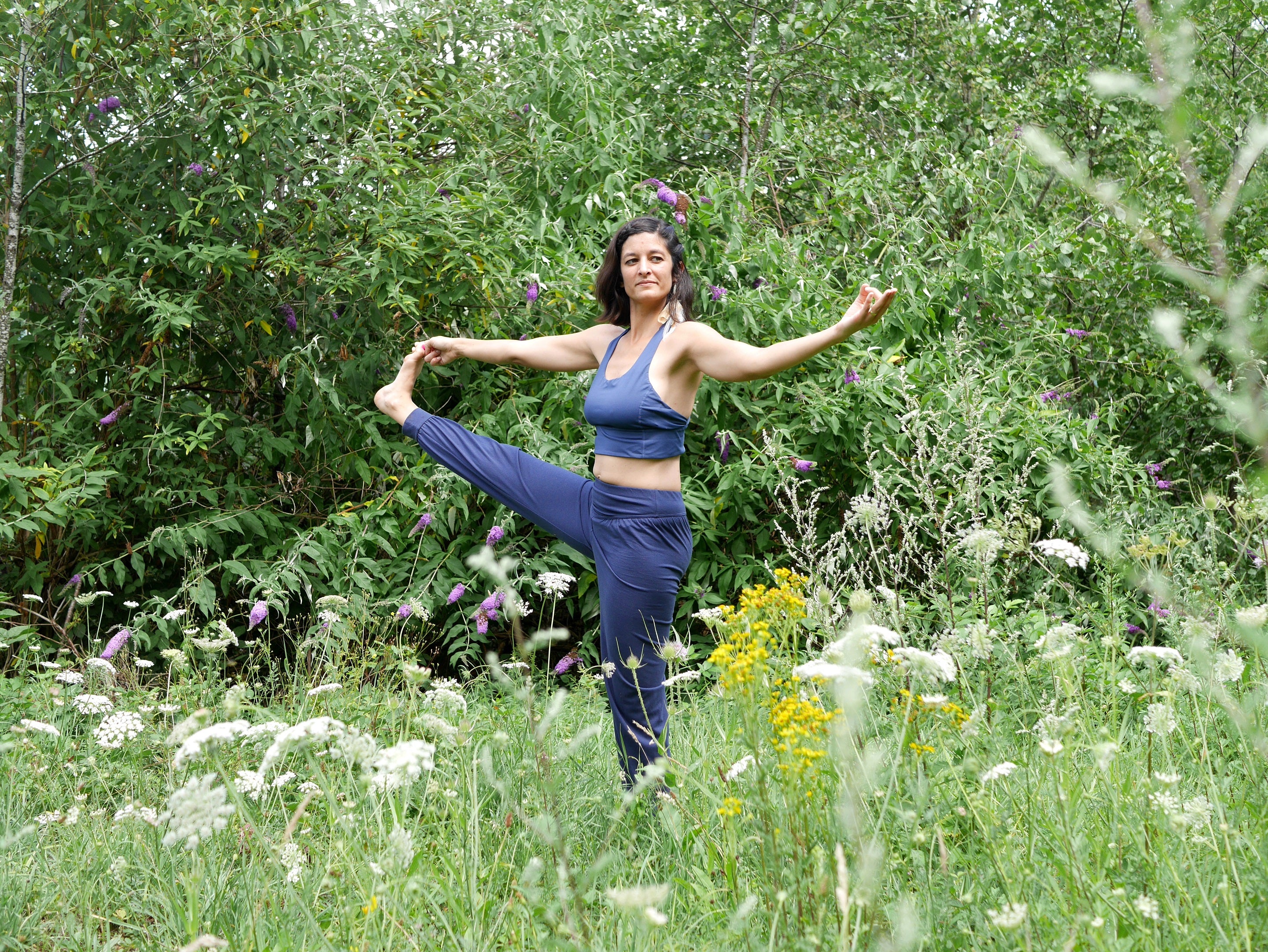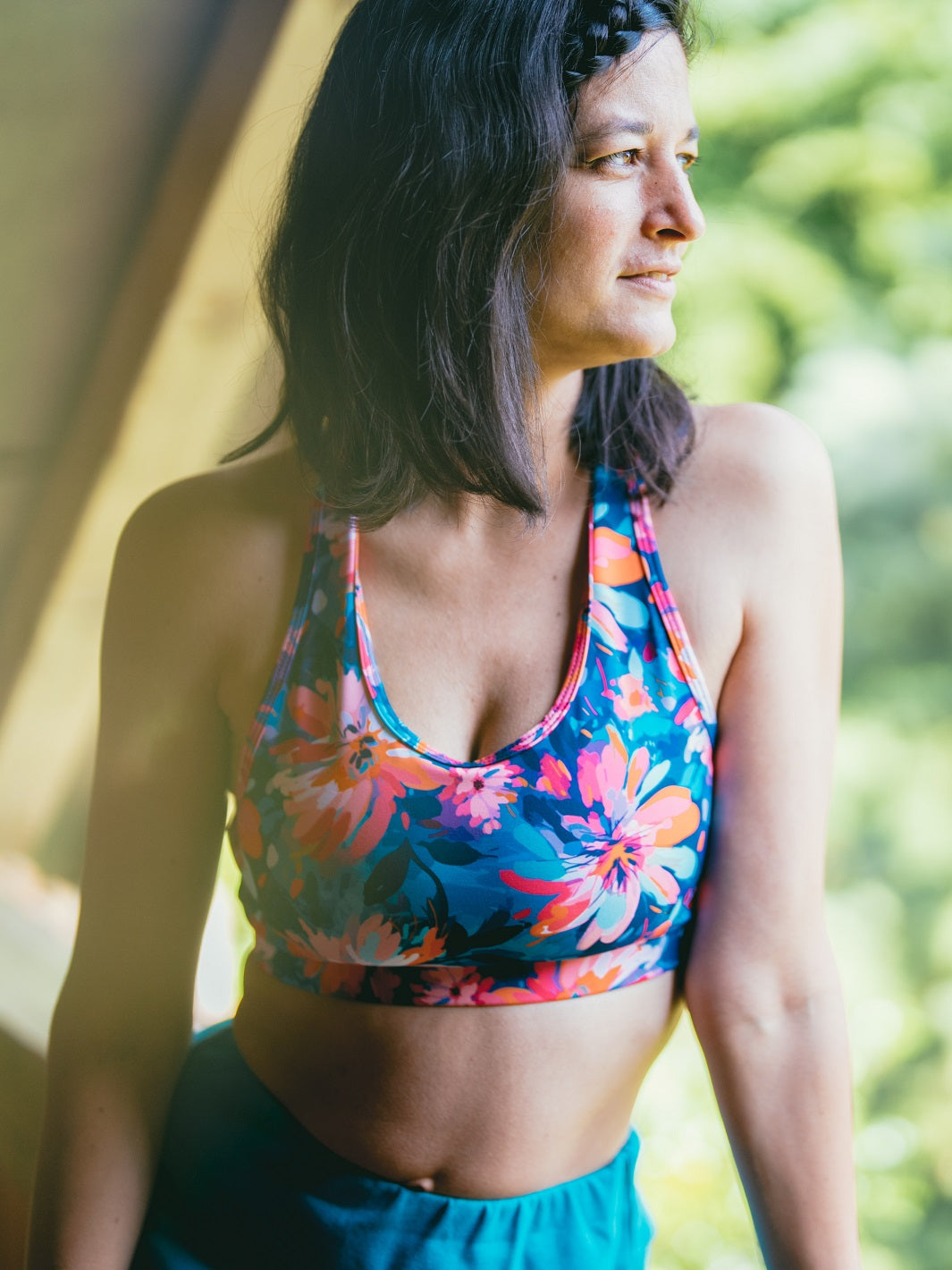That's it, we have just launched our elegant harem pants, in collaboration with Ariane from @yogacoaching!
More than 8 months of intense reflection, questionnaires to collect your desires and needs, and above all, no less than 3 prototypes before obtaining the perfect result!
Designing well-tailored clothes takes time.
But let's get back to our topic: harem pants.
We hesitated a lot about the name of our latest addition because it is clearly on the border between harem pants and yoga pants.
These are revisited harem pants, elegant with a flattering and super comfortable cut.
But for you, the word harem pants certainly refers to another cut of clothing.
So, what are harem pants and where does this item of clothing come from?

Origins of harem pants
Sarouel means “pants” in Arabic.
It is a fairly loose unisex garment, worn on the lower part of the body.
It is characterized by a low crotch, sometimes up to the knees, to allow good ventilation of the legs in hot climates.
The fabric is tightened at the ankles to protect against mosquito bites.
Harem pants are everyday pants, a bit like what we know today with jeans.
It is probably an evolved version of the dhoti, a piece of fabric worn by men in India which has the particularity of being tied at the waist and one of the sides of which passes between the legs.
Harem pants are worn by both men and women, whose shapes are not visible.

History of harem pants
Each item of clothing has its story and a group of fans attached to it.
This is the case, for example, of jeans and their thick, very robust cotton fabric which covered the legs of American workers, or the lighter chinos, which were originally British military clothing designed for colonial troops in Asia. from South.
Or even leggings, derived from nylon tights created in the 1960s and which took off with sport at the end of the 2000s.
However, there is one pair of pants that has been able to cross generations for centuries, which is none other than harem pants!
Harem pants are pants that have their origins in the Orient.
The birthplace of harem pants, saroual or even sarwal is China where we found the first traces of the garment, which date back to the 3rd century BC.

The history of harem pants begins in Asia…
Originally from China, harem pants are very popular with riders because they are practical and comfortable.
It was quickly adopted by a new group of people: the merchants of the Far East who also loved it for its comfort during their long wanderings along the Silk Road, through high mountains and burning deserts.
Harem pants naturally spread along the path taken by traders to reach Persia.
There, it was the high dignitaries who adopted it and officially baptized it “saroual”, thus giving it its credentials of nobility.

…and continues in North Africa…
The Arab-Muslim conquest put an end to the Sassanid Empire in Persia and resulted in the democratization of harem pants which spread throughout the Arabian Peninsula, reaching the Andalusian regions.
All levels of society wear it.
Characterized by its soft fabric, its vibrant colors and its adjustment to the ankles, it seduces Arab dignitaries to Mediterranean sailors.
Only the West does not yet know it…

…to then spread to the West
Following the colonization of Algeria by France in the 19th century, harem pants made their entry into Europe and France.
In the United States in the middle of the 19th century, the feminist Amélia Bloomer tried to launch the harem pants fashion and encouraged women to wear them.
It is important to replace long traditional dresses and stifling corsets with clothes that offer more freedom of movement!
Women can finally exercise and feel comfortable Another advantage: harem pants do not collect dirt from the streets, unlike long dresses which are real dust collectors.
Unfortunately, the sauce does not work as hoped and Amélia is even accused of corrupting women and leading them into decadence.
Some women adopt it despite everything, a version of harem pants for cycling is even created.
It was the great French fashion designer and perfumer Paul Poiret, a pioneer of female emancipation and very popular at the start of the 20th century, who gave harem pants a second lease of life.
Known for his daring, he notably eliminated the corset by creating high-waisted dresses).

Unlike Amélia Bloomer who claims harem pants for the feminist cause, Paul Poiret presents them as a fashion item.
Very attracted to oriental and Persian styles, his collections breathe the tales of the thousand and one nights.
In 1911, he exhibited his first harem pants which he called culottes.

At this turning point in history, women's rights are beginning to evolve and demands are becoming more and more pronounced.
Harem pants didn't really take off, but they served as a transition to loose pants, which more and more women adopted during the Second World War.
Yes, women have a pair of legs and it is high time for mentalities to change.
Harem pants conquer the modern era
Harem pants gradually disappeared at the end of the 1920s.
It rose from its ashes in the 1960s and 70s when Western fashion took inspiration from other cultures and places in the world.
This time it comes in the form of pajamas and can be worn as indoor or relaxation clothing.
In the West, harem pants are quickly adopted by small groups.
First it was the backpackers and hippies of the 70s.
Then it's the turn of the partygoers and rappers of the 90s with street culture and hip hop: harem pants turn out to be ideal for dancing and sport.
Today, yogis, skaters and bourgeois-bohemians have adopted it in their wardrobe.
Harem pants are still considered ethnic clothing or linked to hippie culture and many people do not dare to wear them because of its symbol of belonging to these groups.
On the contrary, this originality should be a reason to try it!
Around the world, it is still worn in North Africa, the Middle East and certain regions of Asia such as Nepal.
The different names given to harem pants
Over time, harem pants have had several names.
It takes the nickname “kameez” or “shalwar” in the countries bordering the northern, western and southern slopes of the Himalayan range.
In India, it adopts the name “patalia”.
In Anatolia further west, around the 5th century AD, it was called “salvar”.
In Eastern Europe it is called “sharovary” and in Central Europe “dimije”.
In Africa, we find harem pants under different names: “sirwal”, “sarwel” or even “harem pants”.
In the English-speaking world, they are called “harem pants” or “Aladdin pants” because of the very strong link with oriental culture.
In the French-speaking world, it is mainly known as harem pants but has a few synonyms such as “harem pants” or “baggy pants”.
Harem pants are part of the family of wide pants also known as “baggy”.

How to wear the Géopélie flowing pants?
Our harem pants are very versatile yoga pants and can be worn in different ways.
For your yoga or fitness sessions, you can wear it alone with our GELINOTTE or MESANGE bra:
Or with our TOUKAN or PELICAN t-shirt:
And if the temperatures drop, why not with our HERON sweatshirt:
In everyday life, wear it with your favorite t-shirt or sweatshirt and if you love it so much, why not as pajamas?
Why wear Géopélie harem pants?
Harem pants are by definition the pants of comfort!
Whatever activity you do, you will be comfortable in our harem pants.
The fabric is light, the leg is wide enough not to create friction, the only tightening points are the waist and the ankles, and this is very gentle.
The crotch is very slightly low to let a little air pass through, but not too much either, to keep a very elegant style.
The saourel is our solution for all those who don't particularly like leggings because they feel too tight in them and don't necessarily want to show off their shape.
Don't wait to try it!

The Géopélie x Ariane Yoga Coaching yoga pants
The harem pants from the Géopélie x Ariane @yogacoaching collab also have their own story!
During Delphine's visit to Ariane, the latter shows her a pair of red harem pants bought at a market more than 10 years ago but which Ariane still wears because they are so pleasant.
The famous red harem pants are showing the effect of time a little but many of Ariane's students never fail to ask her where she found them...
From there was born the idea of creating harem pants that are just as comfortable and feminine, in recycled fabrics and made in France, which will last a long time, without getting damaged.
We still decided to keep the name harem pants for its oriental and feminine side, for its fairly wide legs and the tightness at the ankles.
Note, however, that the crotch is not as low as the classic harem pants.
A compromise for today's yoginis who seek comfort above all, without compromising on elegance and versatility.
Because of course, you will wear it all the time once you adopt it!

How to maintain your Géopélie yoga pants?
Made from a jersey knit made from 100% recycled fibers weighing approximately 150g/m², our harem pants can only be washed when they are really dirty or stained on a cold program or on a delicate cycle at 30°C on the 'reverse, with similar colors.
For spinning, choose the setting at 800 rpm maximum.
The harem pants can be ironed inside out, at 110°C maximum.
TO DISCOVER !
Discover here our eco-responsible yoga outfits made in France from recycled materials, perfectly suited to practicing all types of yoga!
And so as not to miss any news from Géopélie, subscribe to our newsletter here at the bottom of the page 👇 we only send a maximum of two per month!





Leave a comment